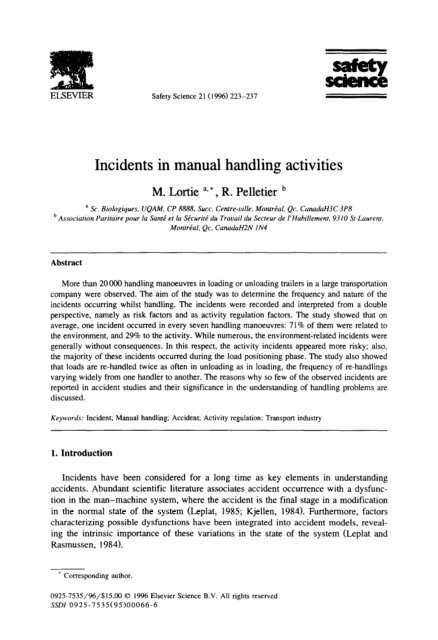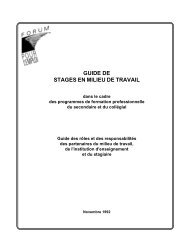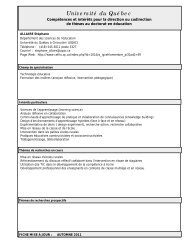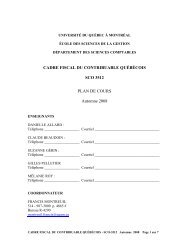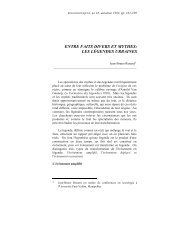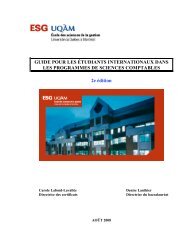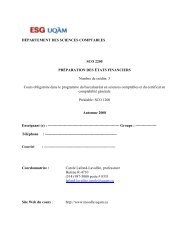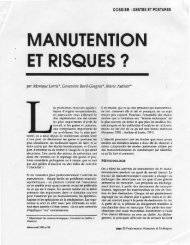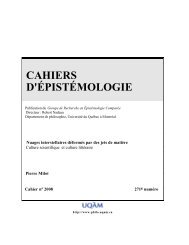Incidents in manual handling activities - UQAM
Incidents in manual handling activities - UQAM
Incidents in manual handling activities - UQAM
Create successful ePaper yourself
Turn your PDF publications into a flip-book with our unique Google optimized e-Paper software.
ELSEVIER Safety Science 21 (1996) 223-237<br />
<strong>Incidents</strong> <strong>in</strong> <strong>manual</strong> handl<strong>in</strong>g <strong>activities</strong><br />
M. Lortie a* * , R. Pelletier b<br />
a SC. Biologiques, <strong>UQAM</strong>, CP 8888, Succ. Cenfre-ville, Montr&l, Qc, CunadaH3C 3P8<br />
b Associution Paritaire pour la Sante’ et la ShuitP du Truvail du Secteur de l’Hahillement, 9310 St-Laurent,<br />
Mont&al, Qc. CannduHZN IN4<br />
Abstract<br />
More than 20 000 handl<strong>in</strong>g manoeuvres <strong>in</strong> load<strong>in</strong>g or unload<strong>in</strong>g trailers <strong>in</strong> a large transportation<br />
company were observed. The aim of the study was to determ<strong>in</strong>e the frequency and nature of the<br />
<strong>in</strong>cidents occurr<strong>in</strong>g whilst handl<strong>in</strong>g. The <strong>in</strong>cidents were recorded and <strong>in</strong>terpreted from a double<br />
perspective, namely as risk factors and as activity regulation factors. The study showed that on<br />
average, one <strong>in</strong>cident occurred <strong>in</strong> every seven handl<strong>in</strong>g manoeuvres: 7 1% of them were related to<br />
the environment, and 29% to the activity. While numerous, the environment-related <strong>in</strong>cidents were<br />
generally without consequences. In this respect, the activity <strong>in</strong>cidents appeared more risky; also,<br />
the majority of these <strong>in</strong>cidents occurred dur<strong>in</strong>g the load position<strong>in</strong>g phase. The study also showed<br />
that loads are re-handled twice as often <strong>in</strong> unload<strong>in</strong>g as <strong>in</strong> load<strong>in</strong>g, the frequency of re-handl<strong>in</strong>gs<br />
vary<strong>in</strong>g widely from one handler to another. The reasons why so few of the observed <strong>in</strong>cidents are<br />
reported <strong>in</strong> accident studies and their significance <strong>in</strong> the understand<strong>in</strong>g of handl<strong>in</strong>g problems are<br />
discussed.<br />
Keywords: Incident; Manual handl<strong>in</strong>g; Accident; Activity regulation; Transport <strong>in</strong>dustry<br />
1. Introduction<br />
<strong>Incidents</strong> have been considered for a long time as key elements <strong>in</strong> understand<strong>in</strong>g<br />
accidents. Abundant scientific literature associates accident occurrence with a dysfunc-<br />
tion <strong>in</strong> the man-mach<strong>in</strong>e system, where the accident is the f<strong>in</strong>al stage <strong>in</strong> a modification<br />
<strong>in</strong> the normal state of the system (Leplat, 198.5; Kjellen, 1984). Furthermore, factors<br />
characteriz<strong>in</strong>g possible dysfunctions have been <strong>in</strong>tegrated <strong>in</strong>to accident models, reveal-<br />
<strong>in</strong>g the <strong>in</strong>tr<strong>in</strong>sic importance of these variations <strong>in</strong> the state of the system (Leplat and<br />
Rasmussen, 1984).<br />
* Correspond<strong>in</strong>g author.<br />
09257535/96/$1.5.00 0 1996 Elsevier Science B.V. All rights reserved<br />
SSDI 0925-7535(95)00066-6
224 M. Lortie, R. Pelletier / Safety Science 21 (1996) 223-237<br />
<strong>Incidents</strong> are dealt with from two perspectives. In the first, <strong>in</strong>cidents are part of a<br />
functional flow diagram <strong>in</strong>tended to express, logically and chronologically, the situations<br />
and events that resulted <strong>in</strong> the accident. The cause tree developed by the INRS <strong>in</strong> France<br />
is a typical example. The second type is more taxonomic <strong>in</strong> nature: it characterizes<br />
<strong>in</strong>cidents, and their significance <strong>in</strong> the orig<strong>in</strong> of accidents is <strong>in</strong>terpreted <strong>in</strong> relation to<br />
their frequency and/or their rank <strong>in</strong> the sequence of events lead<strong>in</strong>g to the accident. The<br />
MAIM (Merseyside Accident Information Model) system, proposed for study<strong>in</strong>g han-<br />
dl<strong>in</strong>g accidents, is one example (Troup et al., 1988). In both cases, the <strong>in</strong>formation is<br />
collected follow<strong>in</strong>g an accident <strong>in</strong>volv<strong>in</strong>g <strong>in</strong>jury.<br />
The concept of <strong>in</strong>cident can also vary greatly, depend<strong>in</strong>g on whether the studies focus<br />
on risks or on system regulation. For example, Hoyos and Zimelong (1988) l<strong>in</strong>k<br />
<strong>in</strong>cidents to risky events, which are, therefore, def<strong>in</strong>ed <strong>in</strong> relation to their potential for<br />
generat<strong>in</strong>g accidents, accord<strong>in</strong>g to the follow<strong>in</strong>g sequence: unsafe <strong>in</strong>cident, <strong>in</strong>cident with<br />
material damage, potential accident, and accident with <strong>in</strong>jury. With Leplat and Ras-<br />
mussen (1984), however, an <strong>in</strong>cident is part of a system-regulation process; the goal of<br />
the operators’ actions is, therefore, to return a system that is not operat<strong>in</strong>g as expected to<br />
the normal state. In this process, operators are reliability agents who must anticipate<br />
<strong>in</strong>cident recovery. Here, the concept of <strong>in</strong>cident therefore has a broader scope because it<br />
is def<strong>in</strong>ed without exclusive reference to the risk of <strong>in</strong>jury. In this latter case, risks can<br />
be anticipated not only from analysis of <strong>in</strong>cidents, but also of the work activity itself.<br />
Up until now, overexertion musculoskeletal <strong>in</strong>juries, particularly back <strong>in</strong>juries and<br />
those associated with handl<strong>in</strong>g <strong>activities</strong>, have been the subject of numerous studies. The<br />
notion of <strong>in</strong>cident is conveyed ma<strong>in</strong>ly from two perspectives. In the first, whether a<br />
dysfunction or an <strong>in</strong>cident occurs or not is used to characterize the “fortuitous” nature<br />
of the accident. This dist<strong>in</strong>ction was <strong>in</strong>troduced by Shannon and Mann<strong>in</strong>g (1980) to<br />
differentiate cases <strong>in</strong> which the <strong>in</strong>jury is itself the only unanticipated event from those<br />
cases <strong>in</strong> which the <strong>in</strong>jury results from another unanticipated event (called a true<br />
accident). With the second perspective - which coexists with the first - the <strong>in</strong>cident<br />
is analyzed ma<strong>in</strong>ly as an <strong>in</strong>jury mechanism (e.g., loss of balance, impact); it is def<strong>in</strong>ed <strong>in</strong><br />
relation to the accident victim, without reference to the system or to any notion of<br />
regulation. It should furthermore be emphasized that the handl<strong>in</strong>g activity itself has been<br />
the subject of only a few studies; the <strong>in</strong>jury mechanism is almost always the only po<strong>in</strong>t<br />
of <strong>in</strong>terest.<br />
A study deal<strong>in</strong>g with 611 accidents <strong>in</strong>volv<strong>in</strong>g handlers load<strong>in</strong>g and unload<strong>in</strong>g trailers<br />
on load<strong>in</strong>g docks showed that one <strong>in</strong>cident or unexpected event other than the accident<br />
itself was reported <strong>in</strong> 58% of the accidents; furthermore, the <strong>in</strong>cidents were of a more<br />
varied nature than what is generally reported <strong>in</strong> the literature (e.g., loss of handgrip,<br />
unexpected <strong>in</strong>stability of the load; Lortie et al., 1996). In addition, <strong>in</strong>terviews with the<br />
handlers revealed that <strong>in</strong>cident prevention was a decid<strong>in</strong>g factor <strong>in</strong> the choice of method<br />
(Authier and Lottie, 1993). <strong>Incidents</strong> that preoccupy handlers are, however, not neces-<br />
sarily risky events. They may be events that occur <strong>in</strong> system regulation. For example,<br />
handlers prefer to use, depend<strong>in</strong>g on the circumstances, a method that allows direct load<br />
position<strong>in</strong>g, where a readjustment of the f<strong>in</strong>al position of the load is unnecessary.<br />
Despite the apparent importance of this phenomenon, no study deal<strong>in</strong>g with the<br />
observation of <strong>in</strong>cidents dur<strong>in</strong>g handl<strong>in</strong>g could be found.
M. Lnrrie, R. Pelletier/Sufety Science 21 (1996) 223-237<br />
The goal of this study was, therefore, to verify the importance of <strong>in</strong>cidents <strong>in</strong><br />
handl<strong>in</strong>g <strong>activities</strong>, whether they are risky events or not.<br />
2. Method<br />
2.1. Subjects and <strong>activities</strong> observed<br />
The <strong>manual</strong> handl<strong>in</strong>g <strong>activities</strong> of 31 handlers load<strong>in</strong>g (n = 14) and unload<strong>in</strong>g<br />
(n = 17) trailers were filmed for one shift each. The subject of the handl<strong>in</strong>g could be an<br />
object such as handl<strong>in</strong>g equipment (e.g., push<strong>in</strong>g on a cart, chang<strong>in</strong>g the forks on a<br />
forklift).<br />
Generally, unload<strong>in</strong>g work consists of identify<strong>in</strong>g the loads and group<strong>in</strong>g them <strong>in</strong>to<br />
lots by dest<strong>in</strong>ation. Goods transferred <strong>manual</strong>ly are generally grouped on carts that are<br />
then brought <strong>in</strong>to the trailer zone correspond<strong>in</strong>g to their dest<strong>in</strong>ation. They are loaded <strong>in</strong>to<br />
the trailer by another handler, whose purpose is to fill the trailer as full as possible and<br />
to make sure that the load is stable and balanced. These moved goods vary greatly <strong>in</strong><br />
type, weight, volume and format, as well as <strong>in</strong> their arrangement <strong>in</strong> the trailers or on the<br />
dock. The <strong>activities</strong> are described <strong>in</strong> greater detail <strong>in</strong> Baril-G<strong>in</strong>gras and Lortie (1995).<br />
Some 20000 handl<strong>in</strong>gs were filmed.<br />
2.2. <strong>in</strong>cident observation<br />
We have def<strong>in</strong>ed an <strong>in</strong>cident as be<strong>in</strong>g any unanticipated or undesired event. The<br />
<strong>in</strong>cident typology was developed from what was mentioned <strong>in</strong> the accident reports and<br />
<strong>in</strong>terviews. However, s<strong>in</strong>ce data collection based on observation and verbalization is<br />
consistent with two different reason<strong>in</strong>gs, we had to structure <strong>in</strong>cident collection <strong>in</strong> a<br />
specific way right from the start. For example, some <strong>in</strong>cidents reported as the first or<br />
only event <strong>in</strong> accidents are observed better as the consequence of another <strong>in</strong>cident. For<br />
<strong>in</strong>stance, “unusual exertion” results almost systematically from another event - it is,<br />
therefore, seen ma<strong>in</strong>ly as a consequence - while it is often reported as the only event <strong>in</strong><br />
accidents. Furthermore, specific circumstances or <strong>in</strong>cidents reported <strong>in</strong> the accident<br />
declaration cannot necessarily be easily translated <strong>in</strong>to “observables” (e.g., good is<br />
heavier than expected or <strong>in</strong> a difficult position). Conversely, easily observable events<br />
may be difficult to report <strong>in</strong> an accident context, particularly if they are seen as partly<br />
related to <strong>in</strong>dividual skills. This is the case of “difficulty mov<strong>in</strong>g” or “difficulty<br />
controll<strong>in</strong>g” a load. They are, however, reported <strong>in</strong> a broader <strong>in</strong>terview context.<br />
The variables reta<strong>in</strong>ed and the observation criteria are summarized <strong>in</strong> Table 1. The<br />
first part of the grid characterized the circumstances of each handl<strong>in</strong>g. Then, the<br />
observer verified whether there was an <strong>in</strong>cident, and if so, whether the <strong>in</strong>cident <strong>in</strong>volved<br />
the activity or the environment, the result of the <strong>in</strong>cident, as well as the handl<strong>in</strong>g phase<br />
<strong>in</strong> which the <strong>in</strong>cident occurred (e.g, pick up, transfer, placement, dur<strong>in</strong>g the entire<br />
handl<strong>in</strong>g). In cases where an <strong>in</strong>cident <strong>in</strong>volved both the activity and the environment, the<br />
observer determ<strong>in</strong>ed the sequence.<br />
225
226<br />
Table 1<br />
Observed variables<br />
1. Handl<strong>in</strong>g circumstances<br />
aObject moved:<br />
.Foot support:<br />
� Teamwork:<br />
ONanne of handl<strong>in</strong>g:<br />
2. Activity-related <strong>in</strong>cidents<br />
� Difficulty controll<strong>in</strong>g:<br />
� <strong>in</strong>accurate position<strong>in</strong>g:<br />
� Difficulty mov<strong>in</strong>g:<br />
@Loss of balance:<br />
@Sudden manoeuvre:<br />
� Impact/catch<strong>in</strong>g on<br />
someth<strong>in</strong>g:<br />
3. Enuironment-related <strong>in</strong>cidents<br />
@Instability:<br />
@Access difficulty:<br />
� Defect:<br />
4. Consequences<br />
� On the activity:<br />
� On the environment:<br />
5. Tim<strong>in</strong>g of the <strong>in</strong>cident<br />
M. Lortie, R. Pellefier/ Safety Science 21 (1996) 223-237<br />
goods (box or other), equipment (a part or all), structural element<br />
(e.g., plate), other.<br />
same level (ground or pallet), one foot on the ground, climbed<br />
on goods, climbed-other.<br />
alone, teamwork (series, parallel, both together),<br />
with the lifter.<br />
regular (f<strong>in</strong>al pick up and placement) versus additional<br />
(before or after regular, other). Regular handl<strong>in</strong>g manoeuvm:<br />
executed all at once or <strong>in</strong> sequence (e.g., when climb<strong>in</strong>g).<br />
<strong>in</strong>cident relat<strong>in</strong>g to grasp or to the displacement procedure chosen.<br />
Typically the handler loses his handgrip, has diffkulty f<strong>in</strong>d<strong>in</strong>g<br />
the way to pick up or position the object.<br />
goods need to be placed aga<strong>in</strong> because the placement is not as<br />
accurate as anticipated.<br />
the object is particularly difficult to handle due to its<br />
weight/and or volume, even if the situation is under control.<br />
with or without fall<strong>in</strong>g; it can be a slight loss of balance,<br />
<strong>in</strong>sofar as it is observable.<br />
it can be to prevent an <strong>in</strong>cident or to respond to a degrad<strong>in</strong>g situation.<br />
between the handler and a fixed object.<br />
any unanticipated movement of an object, piece of equipment,<br />
or element <strong>in</strong> the environment. For example, a box fall<strong>in</strong>g,<br />
a van mov<strong>in</strong>g, a cart mov<strong>in</strong>g.<br />
situations where other objects h<strong>in</strong>der or particularly complicate pick<br />
up or placement.<br />
condition differ<strong>in</strong>g from the usual. For example, a handle that breaks,<br />
a wheel that jams, a hole <strong>in</strong> the ground.<br />
additional manoeuvre, sudden manoeuvre, overexertion, loss of balance,<br />
impact, modification <strong>in</strong> the operative mode, other.<br />
breakage. jamm<strong>in</strong>g, <strong>in</strong>stability, other.<br />
� While handl<strong>in</strong>g (pickup, transfer, placement, all the time), transport<strong>in</strong>g, wait<strong>in</strong>g, mov<strong>in</strong>g without a load.<br />
The nature of the object moved, the level of foot support, whether teamwork was<br />
<strong>in</strong>volved, and the nature of the handl<strong>in</strong>g were character&d. In this last case, so-called<br />
regular handl<strong>in</strong>g where the placement position is f<strong>in</strong>al, was differentiated from so-called<br />
additional handl<strong>in</strong>g, which could take place prior to the f<strong>in</strong>al position<strong>in</strong>g (e.g., sort<strong>in</strong>g<br />
loads) or after the f<strong>in</strong>al position<strong>in</strong>g (e.g., reposition<strong>in</strong>g a load). In reality, and contrary to<br />
what is usually expected, the same object can be handled more than once. The<br />
rehandl<strong>in</strong>g of goods is generally considered by handlers as someth<strong>in</strong>g to be avoided.<br />
An activity-related <strong>in</strong>cident is an event observable <strong>in</strong> the activity; it may be an<br />
obvious <strong>in</strong>ability to control or move the object, a loss of balance, an unanticipated or
M. Lortie, R. Pelletier/ Sufety Science 21 (1996) 223-237 221<br />
sudden handl<strong>in</strong>g, a collision with an immobile object, or an <strong>in</strong>accurate handl<strong>in</strong>g<br />
manoeuvre <strong>in</strong> which the object does not reach the desired f<strong>in</strong>al position. Whilst such<br />
<strong>in</strong>cidents have no pert<strong>in</strong>ence <strong>in</strong> terms of risk, they were, however, reta<strong>in</strong>ed as an<br />
undesired event. This was identified dur<strong>in</strong>g <strong>in</strong>terviews with handlers as one of the<br />
factors considered <strong>in</strong> choos<strong>in</strong>g a handl<strong>in</strong>g method (Authier and Lortie, 1993). Environ-<br />
ment-related <strong>in</strong>cident is an event caused directly by some dysfunctionment <strong>in</strong> the<br />
material environment; it may be an <strong>in</strong>stability of goods or equipment, a specific access<br />
difficulties or a defect of the material. It has to lead to an observable undesired event.<br />
The observed consequences could be the <strong>in</strong>itiation of another <strong>in</strong>cident, namely an<br />
undesirable a priori event such as a rehandl<strong>in</strong>g or a change <strong>in</strong> procedure.<br />
This differentiation of the <strong>in</strong>cidents <strong>in</strong> two groups was based on the need to facilitate<br />
the observational procedure. As a fact, activity and environment are closely related: it<br />
was important to avoid that the observer had to decide constantly if the orig<strong>in</strong> of the<br />
<strong>in</strong>cident was <strong>in</strong> the environment or <strong>in</strong> the activity. Therefore, the differentiation reta<strong>in</strong>ed<br />
was more procedural than conceptual. The observation criteria are presented <strong>in</strong> Table 1.<br />
All the handl<strong>in</strong>g manoeuvres were observed first by an observer, and <strong>in</strong>cident identifica-<br />
tion verified by a second observer.<br />
3. Results<br />
3.1. Ma<strong>in</strong> characteristics of handl<strong>in</strong>g activibes<br />
The ma<strong>in</strong> characteristics are summarized <strong>in</strong> Table 2. More than 20000 handl<strong>in</strong>g<br />
manoeuvres were observed, divided almost equally between load<strong>in</strong>g and unload<strong>in</strong>g. The<br />
Table 2<br />
Handl<strong>in</strong>e manoeuvres observed: their structure and ma<strong>in</strong> characteristics<br />
Object moved<br />
Merchandise:<br />
regular handl<strong>in</strong>g manoeuvre<br />
additional handl<strong>in</strong>g manoeuvre: pre<br />
post<br />
Handl<strong>in</strong>g equipment<br />
Other<br />
Level offhot support<br />
Both feet on the ground or on pallet<br />
One foot on the ground<br />
Climbed on merchandise<br />
Climbed, other<br />
Other<br />
Teamwork<br />
Alone<br />
In a team: serial or parallel work<br />
both together<br />
Load<strong>in</strong>g % Unload<strong>in</strong>g % Total %<br />
(n=10134) (n=10539) (n=20673)<br />
71.9 42.6 67.2<br />
I .5 14.1 8.2<br />
8.4 5.0 6.6<br />
16.5 16.6 16.6<br />
1 .I 1.1 1.4<br />
92.9 96.7 94.8<br />
I .7 0.5 1.1<br />
4.4 1.4 2.9<br />
0.9 1.2 I.1<br />
0.1 0.2 0.1<br />
87.9 95.1 91.6<br />
9.0 3.6 6.2<br />
3.1 1.3 2.2
228 M. Lortie, R. Pelletier/ Safety Science 21 (1996) 223-237<br />
objects moved were goods and equipment <strong>in</strong> 82% and 17% of the cases, respectively.<br />
When the goods were handled, 18% additional manoeuvres were noted, with the<br />
phenomenon be<strong>in</strong>g twice as common <strong>in</strong> unload<strong>in</strong>g (L: 12%, U: 24%). In load<strong>in</strong>g, these<br />
additional manoeuvres, <strong>in</strong> 85% of the cases, followed a regular handl<strong>in</strong>g manoeuvre:<br />
most often, the handler decided to move the already loaded goods aga<strong>in</strong>. In unload<strong>in</strong>g,<br />
on the contrary, 75% of these additional handl<strong>in</strong>g manoeuvres occurred before the<br />
regular handl<strong>in</strong>g. This corresponded ma<strong>in</strong>ly to locat<strong>in</strong>g or sort<strong>in</strong>g operations. Also, 2%<br />
of the regular handl<strong>in</strong>g manoeuvres were carried out <strong>in</strong> at least two separate steps (i.e.,<br />
two pick<strong>in</strong>g up-transfer-placement cycles), with the phenomenon be<strong>in</strong>g twice as preva-<br />
lent <strong>in</strong> unload<strong>in</strong>g. These occurred ma<strong>in</strong>ly when climb<strong>in</strong>g was <strong>in</strong>volved. Only 8% of the<br />
handl<strong>in</strong>g manoeuvres <strong>in</strong>volved teamwork, organized 3 times out of 4 <strong>in</strong> series (one<br />
handler passes the goods to the other) or <strong>in</strong> parallel (the two workers work with the<br />
same cargo, but <strong>in</strong>dependently). Simultaneous lift<strong>in</strong>g of the same goods occurred <strong>in</strong> only<br />
2% of the handl<strong>in</strong>g manoeuvres. In 95% of the cases, the handler had both feet at the<br />
same level, either on the ground or on a pallet. Climb<strong>in</strong>g was observed twice as often <strong>in</strong><br />
load<strong>in</strong>g as unload<strong>in</strong>g (L: 7%, U: 3%).<br />
3.1 .I. Inter-handler variations<br />
Table 3 shows that on average, 33% more goods were handled when load<strong>in</strong>g than<br />
when unload<strong>in</strong>g, and that the number of moved goods varied significantly from one<br />
handler to the next and from one work shift to the next, particularly <strong>in</strong> unload<strong>in</strong>g. The<br />
difference observed between the m<strong>in</strong>imum and maximum values reached a ratio of<br />
almost 5 (752/158). The number of goods was, however, not a good <strong>in</strong>dicator of the<br />
workload; a small number of goods to be moved <strong>manual</strong>ly can represent either an easy<br />
cargo where the forklift will be extensively used, or a difficult cargo consist<strong>in</strong>g of large<br />
objects. The number of additional manoeuvres is on the other hand a good <strong>in</strong>dicator of<br />
difficulty. As shown <strong>in</strong> Table 3, the proportion of loads re-handled varied from 6% to<br />
77%.<br />
Table 3<br />
Handl<strong>in</strong>g manoeuvre frequency: <strong>in</strong>ter-handler variations<br />
Load<strong>in</strong>g ( n = 14)<br />
# of # of ad- % of ad-<br />
loads a ditional ditional<br />
manoeuvres manoeuvres<br />
Mean 498 70 14.1 b<br />
Standard deviation 128 35<br />
Median 514 65<br />
Maximum ’ 702 129 50.0<br />
M<strong>in</strong>imum ’ 259 25 5.7<br />
Unload<strong>in</strong>g ( n = 17)<br />
# of # of ad-<br />
loads ditional<br />
manoeuvres<br />
376 122<br />
135 58<br />
361 91<br />
752 144<br />
158 43<br />
% of ad-<br />
ditional<br />
manoeuvres<br />
a Some handlers assigned to load<strong>in</strong>g may go to help with unload<strong>in</strong>g for short periods and vice versa. These<br />
data were excluded.<br />
b Individual average % were 11.8 for the loaders and 22.2 for the unloaders.<br />
’ These are the absolute maximum and m<strong>in</strong>imum values. Values on the l<strong>in</strong>e may refer to different handlers.<br />
32.4<br />
76.9<br />
13.9
M. Lortie, R. Pellefier/Safety Science 21 (1996) 223-237 229<br />
Table 4<br />
Characteristics of the <strong>in</strong>cidents occurr<strong>in</strong>g dur<strong>in</strong>g load<strong>in</strong>g and unload<strong>in</strong>g of the trailer<br />
Activity-related <strong>in</strong>cident Load<strong>in</strong>g % Unload<strong>in</strong>g % Total %<br />
(n = 462) (n=400) (n= 862)<br />
Difficulty controll<strong>in</strong>g 296<br />
Inaccurate handl<strong>in</strong>g 37.7<br />
Difficulty mov<strong>in</strong>g 17.5<br />
Loss of balance 12.8<br />
Sudden handl<strong>in</strong>g 1.5<br />
Impact/catch<strong>in</strong>g on 0.7<br />
Other 0.2<br />
27.2<br />
28.5<br />
25.0 31.8<br />
34.5 25.4<br />
8.5 10.8<br />
2.0 1.7<br />
1.0 0.8<br />
1.7 0.9<br />
Load Merchandise box 63.8 55.3 59.8<br />
other 28.0 33.3 30.4<br />
Equipment 5.2 8.5 6.7<br />
Other object 3.0 3.0 3.0<br />
Tim<strong>in</strong>g Pick<strong>in</strong>g up 12.3 28.3 19.7<br />
Environment-related <strong>in</strong>cident<br />
Transfer 11.5 10.7 .ll.l<br />
Placement 58.4 32.5 46.4<br />
All the time 8.9 13.7 1 I.1<br />
Other (and other object) 8.9 14.7 11.6<br />
Type Instability<br />
Access difficulty<br />
Defect<br />
Load Merchandise<br />
Equipment<br />
Other object<br />
Tim<strong>in</strong>g Pick<strong>in</strong>g up<br />
Placement<br />
Other<br />
Unrelated<br />
3.2. <strong>Incidents</strong><br />
(n= 902) (n= 1187) (n=2089)<br />
54.2 63.7 59.6<br />
34.2 29.7 31.7<br />
11.6 6.6 8.7<br />
box 41.2 40.2 40.6<br />
other 21.0 8.2 13.7<br />
34.3 48.5 42.4<br />
3.5 3.1 3.3<br />
7.4 2.9 4.9<br />
9.2 3.5 6.0<br />
0.6 0.8 0.7<br />
82.8 92.8 88.5<br />
On average, one <strong>in</strong>cident was observed for every seven handl<strong>in</strong>g manoeuvres (L:<br />
13,5%, U: 15,1%); seven times out of ten, it <strong>in</strong>volved the environment (Env: 71%, Act:<br />
29%). In 14% of the cases, there were two <strong>in</strong>cidents, one <strong>in</strong>volv<strong>in</strong>g the activity and one<br />
<strong>in</strong>volv<strong>in</strong>g the environment. The typology of these <strong>in</strong>cidents is presented <strong>in</strong> Table 4.<br />
3.2.1. Activity-related <strong>in</strong>cidents<br />
Three types of <strong>in</strong>cidents expla<strong>in</strong> 85% of the observed <strong>in</strong>cidents: <strong>in</strong>accurate position-<br />
<strong>in</strong>g (32%), difficulty controll<strong>in</strong>g the object (28%), and difficulty mov<strong>in</strong>g the object<br />
(25%). Loss of balance ranked fourth with 11% of the <strong>in</strong>cidents. Unplanned or sudden
Table 5<br />
Tim<strong>in</strong>g of the <strong>in</strong>cidents <strong>in</strong> relation to the handl<strong>in</strong>g activity<br />
all the<br />
time<br />
Type of <strong>in</strong>cident Load<strong>in</strong>g<br />
Unload<strong>in</strong>g<br />
Total<br />
pick transfer place all the pick transfer place all the pick transfer place<br />
UD % % ment% time % up % % ment % time % uo% % ment%<br />
Control difficulty 24.8 18.6 54.8 3.9 45.1 17.6 30.4 6.9 33.8 18.2 42.9 5.2<br />
Mov<strong>in</strong>g difficulty 10.7 16.0 25.3 48.0 33.0 10.4 16.5 40.0 24.2 12.6 20.0 43.2<br />
Loss of balance 12.2 29.3 58.5 0.0 30.0 30.0 35.0 5.0 I8,O 29.5 50.8 1.6
hf. Lortie, R. Pelletier/Safety Science 21 (1996) 223-237 231<br />
manoeuvres represented only 2% of the <strong>in</strong>cidents <strong>in</strong>volv<strong>in</strong>g the activity. These <strong>in</strong>cidents<br />
were, however, distributed differently depend<strong>in</strong>g on whether load<strong>in</strong>g or unload<strong>in</strong>g was<br />
tak<strong>in</strong>g place. For example, “<strong>in</strong>accurate position<strong>in</strong>g” and “loss of balance” were one<br />
and one-half times more prevalent <strong>in</strong> load<strong>in</strong>g, while conversely, “specific difficulty<br />
mov<strong>in</strong>g” objects was observed twice as often <strong>in</strong> unload<strong>in</strong>g.<br />
Most <strong>in</strong>cidents occurred <strong>in</strong> handl<strong>in</strong>g a load, most often a box (60%). However, boxes<br />
made up more than 90% of the moved goods. Boxes were more often <strong>in</strong>volved <strong>in</strong><br />
<strong>in</strong>cidents dur<strong>in</strong>g load<strong>in</strong>g than unload<strong>in</strong>g (L: 64%, U: 55%). A more detailed analysis of<br />
the type of <strong>in</strong>cident <strong>in</strong> relation to the type of goods showed, however, that goods other<br />
than boxes were the source of 55% of <strong>in</strong>cidents where difficulty mov<strong>in</strong>g the goods was<br />
observed, and of 49% of cases <strong>in</strong>volv<strong>in</strong>g loss of balance.<br />
It was also noted that <strong>in</strong>cidents generally occurred at a specific stage <strong>in</strong> the handl<strong>in</strong>g<br />
manoeuvre, most frequently at placement (46%). The transfer itself most often occurred<br />
without <strong>in</strong>cident. However, it was noted that the handl<strong>in</strong>g step where most <strong>in</strong>cidents<br />
occurred differed, depend<strong>in</strong>g on whether load<strong>in</strong>g or unload<strong>in</strong>g was tak<strong>in</strong>g place. In<br />
load<strong>in</strong>g, <strong>in</strong>cidents occurred significantly more often at placement (58%), while <strong>in</strong><br />
unload<strong>in</strong>g, they were observed almost equally <strong>in</strong> pick<strong>in</strong>g up the load (28%) and at<br />
placement (32%). The analysis was therefore expanded to relate the handl<strong>in</strong>g step to the<br />
type of <strong>in</strong>cident, except for “<strong>in</strong>accurate position<strong>in</strong>g” which, by def<strong>in</strong>ition, essentially<br />
refer to placement. The results <strong>in</strong> Table 5 show that “control difficulties” were more<br />
prevalent dur<strong>in</strong>g placement when load<strong>in</strong>g (53%), and <strong>in</strong> pick<strong>in</strong>g up the load dur<strong>in</strong>g<br />
unload<strong>in</strong>g (45%). Loss of balance was also more prevalent <strong>in</strong> placement dur<strong>in</strong>g load<strong>in</strong>g<br />
(58%), while <strong>in</strong> unload<strong>in</strong>g, it was observed almost equally at all stages <strong>in</strong> the handl<strong>in</strong>g.<br />
F<strong>in</strong>ally, “specific difficulty mov<strong>in</strong>g” was, <strong>in</strong> load<strong>in</strong>g, twice as frequent <strong>in</strong> placement as<br />
<strong>in</strong> pick<strong>in</strong>g up the load, while the opposite was true <strong>in</strong> unload<strong>in</strong>g.<br />
A comparison of the handl<strong>in</strong>g circumstances of these <strong>in</strong>cidents (Table 6) to the<br />
circumstances <strong>in</strong> all of the handl<strong>in</strong>g manoeuvres (Table 2) revealed that at the time of<br />
these <strong>in</strong>cidents, the handlers had climbed twice as often. The difference was especially<br />
marked <strong>in</strong> load<strong>in</strong>g (L: 18%, U: 7%). When the handler was climbed, losses of balance<br />
were the most frequently ensu<strong>in</strong>g <strong>in</strong>cidents; however, they represented only one third of<br />
Table 6<br />
Circumstances related to the Occurrence of activity <strong>in</strong>cidents<br />
Foot support<br />
Both feet on the ground or on pallet<br />
One foot on the ground<br />
Climbed on merchandise<br />
Climbed, other<br />
Other<br />
Teumwork<br />
Alone<br />
In a team work serial or parallel<br />
together<br />
Load<strong>in</strong>g Unload<strong>in</strong>g Total<br />
82.0 93.0 87.1<br />
2.6 0.7 1.7<br />
11 .I 2.5 7.4<br />
3.2 3.5 3.4<br />
0.4 0.3 0.3<br />
88.9 93.0 90.8<br />
6.1 1.3 3.8<br />
5.0 5.7 5.3
232 M. Lortie, R. Pelletier/Sufety Science 21 (1996) 223-237<br />
the observed <strong>in</strong>cidents. Teamwork was also more prevalent with <strong>in</strong>cidents, but the<br />
difference was essentially due to situations <strong>in</strong> which the handlers move the same object<br />
at the same time.<br />
As mentioned <strong>in</strong> the observation grid description, <strong>in</strong>cidents may <strong>in</strong>itiate other<br />
unanticipated activity-related or environment-related events; some of these consequences<br />
are potentially risky, while others are not. The analysis shows that 50% of the <strong>in</strong>cidents<br />
led to consequences <strong>in</strong> the activity (L: 53%, U: 45%). However, <strong>in</strong> 72% of the cases, the<br />
<strong>in</strong>itiated event had no specific risk. Ma<strong>in</strong>ly, additional manoeuvres or changes <strong>in</strong><br />
methods were <strong>in</strong>volved. <strong>Incidents</strong> dur<strong>in</strong>g unload<strong>in</strong>g nonetheless produced dangerous<br />
consequences, as for example, loss of balance, overexertion (L: 22%, U: 34%).<br />
However, only 5% of these <strong>in</strong>cidents had an impact on the environment; basically, it<br />
was <strong>in</strong>stability <strong>in</strong> the goods or equipment.<br />
Loss of balance was observed as an activity <strong>in</strong>cident or as a result of another <strong>in</strong>cident.<br />
Particular attention was paid to this s<strong>in</strong>ce it is often reported as a major accident<br />
circumstance. In this study, some imbalance <strong>in</strong> the handler was observed on 93<br />
occasions as a first event, and on 28 occasions as the result of another <strong>in</strong>cident (Act:<br />
71%, Env: 29%) <strong>in</strong> a total of more than 20000 handl<strong>in</strong>g manoeuvres. Only four of these<br />
losses of balance resulted <strong>in</strong> a fall. F<strong>in</strong>ally, 92% of these losses of balance, as a first<br />
<strong>in</strong>cident, occurred dur<strong>in</strong>g the handl<strong>in</strong>g of goods, and 63% dur<strong>in</strong>g load<strong>in</strong>g. In 40% of the<br />
cases, the handler had climbed, or was not work<strong>in</strong>g with both feet at the same level.<br />
3.2.2. Environment-related <strong>in</strong>cidents<br />
Cases of <strong>in</strong>stability dom<strong>in</strong>ated <strong>in</strong> load<strong>in</strong>g and unload<strong>in</strong>g (L: 54%, U: 64%). Access<br />
difficulties represented approximately one third of the <strong>in</strong>cidents (L: 34%, U: 30%) and<br />
defects 9% (L: 12%, U: 7%). Contrary to activity-related <strong>in</strong>cidents, the characteristics of<br />
environment-related <strong>in</strong>cidents were practically the same for the two functions. In this<br />
type of <strong>in</strong>cident, the object <strong>in</strong>volved was often someth<strong>in</strong>g other than the object be<strong>in</strong>g<br />
handled. Thus, 42% of these <strong>in</strong>cidents <strong>in</strong>volved equipment, particularly carts (L: 34%,<br />
U: 49%), while the equipment was be<strong>in</strong>g handled at the time of the <strong>in</strong>cident <strong>in</strong> only 10%<br />
of the cases. Furthermore, Table 4 shows that <strong>in</strong> 89% of the cases, the moment at which<br />
the <strong>in</strong>cident occurred was unrelated to the handl<strong>in</strong>g be<strong>in</strong>g carried out (e.g., a cart moved<br />
while the handler was do<strong>in</strong>g someth<strong>in</strong>g else a few feet away).<br />
The two ma<strong>in</strong> sources of <strong>in</strong>stability were goods and equipment, but it was the latter,<br />
particularly dur<strong>in</strong>g unload<strong>in</strong>g, that was most often <strong>in</strong>volved (L: 59%, U: 72%). These<br />
<strong>in</strong>stabilities had no impact on the activity <strong>in</strong> 78% of the cases; the handler <strong>in</strong> fact<br />
performed no recovery action dur<strong>in</strong>g or after the <strong>in</strong>cident (L: 79%, U: 77%). When<br />
recovery took place, it was essentially to return the object <strong>in</strong>volved to its orig<strong>in</strong>al<br />
position. Only 6% of these <strong>in</strong>stabilities required a potentially risky response (L: 5%, U:<br />
7%), the most prevalent be<strong>in</strong>g an unanticipated movement to control the <strong>in</strong>stability.<br />
The same picture emerges for all of the <strong>in</strong>cidents: <strong>in</strong> 70% of the cases, the <strong>in</strong>cident<br />
had no impact on the handler’s activity; recovery had a potential risk <strong>in</strong> only 9% of the<br />
cases. Only 4% of these <strong>in</strong>cidents had an impact on the environment; a series of events<br />
was therefore rare. F<strong>in</strong>ally, similar to activity-related <strong>in</strong>cidents, boxes were more often<br />
<strong>in</strong>volved than other goods (74% versus 25%), particularly <strong>in</strong> unload<strong>in</strong>g (L: 66%, U:<br />
83%).
4. Discussion<br />
M. Lortie, R. Pelletier/Safety Science 21 (1996) 223-237 233<br />
As mentioned <strong>in</strong> the <strong>in</strong>troduction, the study of <strong>in</strong>cidents falls with<strong>in</strong> the scope of<br />
studies whose purpose is sometimes the study of risks and sometimes the study of<br />
system regulation. In this study, we have attempted to comb<strong>in</strong>e the two objectives.<br />
Studies focus<strong>in</strong>g specifically on each of these objectives would certa<strong>in</strong>ly have consid-<br />
ered elements that are not dealt with here. Hence, a study focus<strong>in</strong>g on regulation would<br />
have <strong>in</strong>cluded parameters characteriz<strong>in</strong>g the regulatory response. This was not done. A<br />
study focus<strong>in</strong>g on risks might have <strong>in</strong>cluded an a priori evaluation of the “safety” of the<br />
<strong>activities</strong> or the environment as such. Here, no attempt to characterize the environment<br />
beforehand (e.g. the condition of the floors) was made. <strong>Incidents</strong> were noted only if they<br />
resulted <strong>in</strong> observable events. However, consider<strong>in</strong>g the two objectives simultaneously<br />
produces a rather more complete picture of the unanticipated or undesired events.<br />
4.1. <strong>Incidents</strong> as risk factors<br />
Accident analysis (Lortie et al., 1996) has shown that approximately one third of the<br />
<strong>in</strong>juries were caused by an object other than the handled object; observation shows that<br />
environment-related <strong>in</strong>cidents are <strong>in</strong> fact prevalent. For another third of the accidents, it<br />
was the moved object that <strong>in</strong>jured the handler. Incident analysis confirms that <strong>in</strong>cidents<br />
such as “control difficulties” or “equipment defects” are prevalent. An <strong>in</strong>cident was<br />
reported <strong>in</strong> 58% of the accident declarations. The high rate of observed <strong>in</strong>cidents <strong>in</strong> fact<br />
reveals an activity where there are many imponderables, even if they are often without<br />
consequence. The <strong>in</strong>cidents most often reported <strong>in</strong> accidents-<strong>in</strong>stability (25% of the<br />
reported <strong>in</strong>cidents), control difficulties (19%), and defects (17%) correspond to regularly<br />
observed events. The picture emerg<strong>in</strong>g from <strong>in</strong>cident observation and accident analysis<br />
can therefore be said to be compatible.<br />
Most <strong>in</strong>cidents are observed at the moment of placement. Comparison with accidents<br />
is difficult, because the moment when the accident occurs <strong>in</strong> relation to a handl<strong>in</strong>g<br />
manoeuvre is not regularly reported. Almost all studies and recommendations focus on<br />
the <strong>in</strong>itial phase of handl<strong>in</strong>g, namely pick<strong>in</strong>g up the load, and the importance of<br />
placement-related problems are ignored.<br />
As mentioned <strong>in</strong> the <strong>in</strong>troduction, studies focus<strong>in</strong>g on musculoskeletal <strong>in</strong>juries and<br />
particularly back <strong>in</strong>juries sometimes classify accidents <strong>in</strong> two groups, namely, whether<br />
the <strong>in</strong>jury is itself the first and only unanticipated event, or whether it is preceded by<br />
another event, such as slipp<strong>in</strong>g (Mann<strong>in</strong>g et al., 1984). Based on this dist<strong>in</strong>ction, it is<br />
roughly estimated that <strong>in</strong> one <strong>in</strong>jury <strong>in</strong> two, and even more, there is no cause: the worker<br />
was do<strong>in</strong>g his normal work (Mann<strong>in</strong>g, 1985; Troup et al., 1988). Incident observation<br />
leads to the conclusion that the proportion of accidents that occur without any apparent<br />
reason are possibly overestimated. On the one hand, the notion of “usual” handl<strong>in</strong>g is<br />
difficult to def<strong>in</strong>e; goods vary all the time, as does the handl<strong>in</strong>g context. What is usual is<br />
variability. Furthermore, several of the observed <strong>in</strong>cidents correspond to events that may<br />
be difficult to express <strong>in</strong> words <strong>in</strong> an accident declaration. Also, as Nicholson (1985)<br />
emphasizes, the development of data collection systems responds to management goals<br />
and not to prevention goals. The events reta<strong>in</strong>ed are generally those that are directly
234 M. Lmtie, R. Pelletier /Safety Science 21 (1996) 223-237<br />
related to the <strong>in</strong>jury, such as a loss of balance, a sudden movement, or an impact. Very<br />
few studies reported <strong>in</strong>cidents such as “loss of handgrip” (Troup et al., 19881, control<br />
difficulties and access problems. These frequently observed <strong>in</strong>cidents are possibly rarely<br />
mentioned <strong>in</strong> published accident analyses not so much because they are never reported,<br />
but rather because this <strong>in</strong>formation is not analyzed. Such a classification bias has already<br />
been mentioned by Strandberg (19851, and Mann<strong>in</strong>g et al. (1988), for data on loss of<br />
balance.<br />
Up until now, several researchers have speculated on whether the reported circum-<br />
stances depended on the severity of the <strong>in</strong>jury. This question is important from a<br />
practical standpo<strong>in</strong>t because it determ<strong>in</strong>es the pert<strong>in</strong>ence of study<strong>in</strong>g m<strong>in</strong>or accidents,<br />
which are more numerous, and by extension, <strong>in</strong>cidents. Currently, there does not seem to<br />
be a clear consensus emerg<strong>in</strong>g on this question. For example, some authors reta<strong>in</strong> the<br />
<strong>in</strong>formations on an accident only for those followed by a m<strong>in</strong>imum of three days of<br />
absence. Some have found that the nature of the <strong>in</strong>formation collected changes,<br />
depend<strong>in</strong>g on whether or not it is a m<strong>in</strong>or accident be<strong>in</strong>g reported (Lait<strong>in</strong>en, 1982;<br />
Niskanen, 1985), while others have noted that the circumstances reported are practically<br />
the same (Laughery and Vaubel, 1993). In the case of <strong>in</strong>cidents, the authors speculated<br />
whether by simply observ<strong>in</strong>g them, the ma<strong>in</strong> accident risks could be determ<strong>in</strong>ed, and<br />
whether the conclusions that would be drawn, without know<strong>in</strong>g the accident picture,<br />
would be correct.<br />
The response to this question is mixed. Environment-related <strong>in</strong>cidents are very<br />
prevalent. They occur, however, most often <strong>in</strong>dependently of the specific handl<strong>in</strong>g<br />
activity carried out at that moment and they <strong>in</strong>volve most often a material which is<br />
outside the immediate handler’s contact zone. Only 9% of these <strong>in</strong>cidents have a<br />
consequence - for example, a recovery action - which has a potential risk. Their real<br />
importance therefore emerges from the accident analysis. Conversely, it is easy to<br />
understand why activity-related accidents such as “difficulty controll<strong>in</strong>g” or “difficulty<br />
mov<strong>in</strong>g” are risky. In fact, 70% of activity-related <strong>in</strong>cidents <strong>in</strong>dicate per se that the<br />
handl<strong>in</strong>g <strong>in</strong>volved some difficulties. Accident analysis confirms this <strong>in</strong>terpretation.<br />
However, the importance of balance problems clearly would not have been obvious just<br />
from observ<strong>in</strong>g them. Loss of balance situations occurr<strong>in</strong>g <strong>in</strong> a handl<strong>in</strong>g activity are<br />
known to be a major source of <strong>in</strong>juries (Niskanen, 1985; Mann<strong>in</strong>g et al., 1984; David,<br />
1985). The study of handl<strong>in</strong>g accidents, as well as the <strong>in</strong>terviews with the handlers<br />
(Authier and Lortie, 1993), confirm the importance of the phenomenon. In this study, an<br />
average of 170 handl<strong>in</strong>g <strong>activities</strong> had to be viewed <strong>in</strong> order to observe some loss of<br />
balance, sometimes just a slight unstead<strong>in</strong>ess, and more than 5,000 handl<strong>in</strong>g <strong>activities</strong><br />
had to be viewed to observe a fall. The importance of the problem could not have been<br />
<strong>in</strong>ferred simply by observ<strong>in</strong>g these <strong>in</strong>cidents. Consequently, accident analysis rema<strong>in</strong>s an<br />
essential step <strong>in</strong> the diagnosis.<br />
Nonetheless, a few <strong>in</strong>terest<strong>in</strong>g po<strong>in</strong>ts emerged from observation of these losses of<br />
balance. First, <strong>in</strong> 75% of the cases (93/121), loss of balance was the first unexpected<br />
event and it was caused by noth<strong>in</strong>g other than the handl<strong>in</strong>g activity. In the accident<br />
descriptions, the handler, moreover, omitted mention<strong>in</strong>g the cause of the loss of balance.<br />
For example, the condition of the floor was only rarely mentioned. However, observa-<br />
tion showed that <strong>in</strong> 40% of the cases, the handler did not have both feet on the ground.
M. Lortie, R. Pelletier/Safety Science 21 (1996) 223-237 235<br />
At the present time, handl<strong>in</strong>g-related loss of balance is ma<strong>in</strong>ly analyzed from the<br />
standpo<strong>in</strong>t of slipp<strong>in</strong>g: as a result, much attention is paid to the shoe-ground friction<br />
coefficient, which is possibly not the best means to a solution. Furthermore, most of the<br />
observed losses of balance, as well as those described <strong>in</strong> the accidents, are seen to<br />
correspond poorly to the normally reta<strong>in</strong>ed triplet of slipp<strong>in</strong>g-tripp<strong>in</strong>g-fall<strong>in</strong>g. These<br />
favoured classification modalities may be prevent<strong>in</strong>g these other loss-of-balance circum-<br />
stances from be<strong>in</strong>g recognized.<br />
F<strong>in</strong>ally, the sequential nature of the <strong>in</strong>cidents make them difficult to analyze <strong>in</strong><br />
accidents. The analysis grid used <strong>in</strong> this study was developed to make observation easier<br />
<strong>in</strong> order to achieve a high rate of <strong>in</strong>ter-observer reproducibility <strong>in</strong> a context were the<br />
activity and the environment are closely related. The differentiation of <strong>in</strong>cidents, namely<br />
whether they are environment- or activity-related, and the <strong>in</strong>troduction of the notion of<br />
consequence, proved to be an effective solution for the observation. This could also<br />
make the analysis of accidents easier, as well as their <strong>in</strong>terpretation. It must be<br />
remember however, that it was a procedural decision; results <strong>in</strong>dicate where <strong>in</strong>cidents<br />
were observed or detected, not their causes.<br />
4.2. Incident observation as a regulation factor<br />
<strong>Incidents</strong> depend on the handl<strong>in</strong>g context (e.g., load<strong>in</strong>g, unload<strong>in</strong>g, arrangement of<br />
goods, type of goods) as well as the load<strong>in</strong>g or unload<strong>in</strong>g strategy developed by each<br />
handler and on his skills. For example, the order <strong>in</strong> which a handler unloads goods has<br />
an impact on the number of times he will climb and on the spatial context of each<br />
handl<strong>in</strong>g manoeuvre. This will then have an impact on the <strong>in</strong>cidents. In load<strong>in</strong>g, some<br />
workers can visualize with remarkable precision the available space, while others<br />
proceed by trial and error. Incident occurrence seems also to depend on the importance<br />
that is given to it by each handler. For example, the placement of goods is much more<br />
systematically precise with some handlers than with others. This may be a question of<br />
skill, but also probably of choice, as it is with <strong>in</strong>stability of equipment. Hence, cart<br />
stability depends, of course, on the support<strong>in</strong>g surface, but also on the way it is placed<br />
and the way the goods are placed on it, and, therefore, on the way they are handled. All<br />
handlers do not give the same importance to its stability. Some techniques also <strong>in</strong>volve<br />
less exertion, but s<strong>in</strong>ce they require more skill, they can be associated with more<br />
<strong>in</strong>cidents. Thus, <strong>in</strong>cidents depend simultaneously on the handl<strong>in</strong>g context, and on the<br />
strategy and the skills of each worker, but conversely, they also determ<strong>in</strong>e the strategies.<br />
Strategies not only have an impact on the “quality” of the handl<strong>in</strong>g activity, but also<br />
on the “quantity”. For example, some handlers beg<strong>in</strong> the handl<strong>in</strong>g only when they have<br />
a general idea of all of the goods to be loaded. They load the goods only <strong>in</strong> a<br />
predeterm<strong>in</strong>ed order. Others load as they proceed, even if it means mov<strong>in</strong>g the goods to<br />
a new location later. In unload<strong>in</strong>g, it is the sort<strong>in</strong>g strategy that directly affects the<br />
number of additional handl<strong>in</strong>g <strong>activities</strong>. In both cases, the use of these strategies<br />
implies the existence of important cognitive <strong>activities</strong>.<br />
Most recommendations are based on experimental studies where everyth<strong>in</strong>g takes<br />
place without <strong>in</strong>cident. Hence, symmetric grips are almost systematically recommended,<br />
based on biomechanical criteria, even though experimental studies show that these grips
236 M. Lortie, R. Pelletier/ Safety Science 21 (1996) 223-237<br />
are useful for stabiliz<strong>in</strong>g the conta<strong>in</strong>er (Coury and Drury, 1982). However, studies<br />
carried out on handlers show that the latter clearly favour asymmetrical grips (Drury et<br />
al., 1982; Baril-G<strong>in</strong>gras and Lortie, 1995; Authier et al., 19951, as this offers them major<br />
advantages <strong>in</strong> controll<strong>in</strong>g and maneuver<strong>in</strong>g the load. This study confirms the pert<strong>in</strong>ence<br />
of these selection criteria. Incident prevention, like recovery, is <strong>in</strong> fact cont<strong>in</strong>uously<br />
<strong>in</strong>volved <strong>in</strong> the choice of handl<strong>in</strong>g technique. Consequently, it seems that accident<br />
prevention cannot be achieved and based on solely biomechanical criteria; <strong>in</strong>cident<br />
prevention or recovery must also be considered.<br />
5. Conclusion<br />
<strong>Incidents</strong> are an <strong>in</strong>tegral part of handl<strong>in</strong>g work. Their identification and analysis are<br />
essential <strong>in</strong> understand<strong>in</strong>g not only the risks associated with handl<strong>in</strong>g <strong>activities</strong> but also<br />
the choices made by the handlers. These choices may <strong>in</strong>volve a handl<strong>in</strong>g technique, as<br />
well as the overall strategy. These choices imply the existence of relatively complex<br />
cognitive processes. Unfortunately, the methods recommended and taught take these<br />
aspects very little <strong>in</strong>to consideration.<br />
References<br />
Authier, M and Lortie, M., 1993. Assessment of factors considered to be important <strong>in</strong> handl<strong>in</strong>g tasks by expert<br />
handlers. Int. J. Ind. Erg., 13(11): 331-340.<br />
Authier, M., Lottie, M. and Gagnon, M.. 1995. Manual handl<strong>in</strong>g techniques: compar<strong>in</strong>g novices and experts.<br />
Int. J. Ind. Erg. (paper accepted).<br />
Baril-G<strong>in</strong>gras, G. and Lortie, M., 199.5. The handl<strong>in</strong>g of objects other than boxes: univariate analysis of<br />
handl<strong>in</strong>g techniques <strong>in</strong> a large transport company. Ergonomics, 38(5): 905-925.<br />
Coury, B.G. and Drttry, C.G., 1982. Optimum handle positions <strong>in</strong> a box-hold<strong>in</strong>g task. Ergonomics, 25(7):<br />
645-662.<br />
David, G.C., 1985. UK national statistics on handl<strong>in</strong>g accidents and lumbar <strong>in</strong>juries at work. Ergonomics,<br />
28(l): 9-16.<br />
Dnrry, C.G., Law, C.-H. and Pawenski, 8, 1982. A survey of <strong>in</strong>dustrial box handl<strong>in</strong>g. Human Factors, 24(5):<br />
553-565.<br />
Hoyos, C.G. and Zimelong, B., 1988. Occupational safety an accident prevention. Behavioral strategies and<br />
methods (Elsevier, Amsterdam).<br />
Kjellen, U., 1984. The deviation concept <strong>in</strong> occupational accident control: 1. Defmition and classification.<br />
Act. Anal. Prev., 16(4): 289-306.<br />
Laughery, K.R. and Vaubel, K.P., 1993. Major and m<strong>in</strong>or <strong>in</strong>juries at work: Are the circumstances similar or<br />
different? hit. J. Ind. Erg. 12 (4): 273-279.<br />
Lait<strong>in</strong>en, H., 1982. Report<strong>in</strong>g non <strong>in</strong>jury accidents: a tool <strong>in</strong> accident prevention. J. Oct. Act., 42-4):<br />
275-280.<br />
Leplat, J. and Rasmussen, J., 1984. Analysis of human errors <strong>in</strong> <strong>in</strong>dustrial <strong>in</strong>cidents and accidents for<br />
improvement of work safety. Act. Anal. Prev., 16(2): 77-88.<br />
Leplat, J., 1985. Erreur huma<strong>in</strong>e, fiabilite huma<strong>in</strong>e dans le travail (Armand Coll<strong>in</strong>, Paris).<br />
Lottie, M., Lamonde, F., Coll<strong>in</strong>ge, C. and Tellier, C., 1996. Analyse des accidents associts au travail de<br />
manutentionnaire darts le secteur du transport. Travail Huma<strong>in</strong>, (paper accepted, expected date of<br />
publication: April).
M. Lortie, R. Pellerier/ Safety Science 21 (1996) 223-237 231<br />
Mann<strong>in</strong>g, D.P., Mitchell, R.G. and Blanchfield, P.L., 1984. Body movements and events contribut<strong>in</strong>g to<br />
accidental and non-accidental back <strong>in</strong>juries. Sp<strong>in</strong>e, 9f7): 734-739.<br />
Mann<strong>in</strong>g, D.P., 1985. Use of an accident model to <strong>in</strong>vestigate and record causes of back <strong>in</strong>juries. Ergonomics,<br />
28(l): 237-243.<br />
Mann<strong>in</strong>g, D.P., Ayers, I., Jones, C., Bruce, M. and Cohen, K. 1988. The <strong>in</strong>cidence of underfoot accidents<br />
dur<strong>in</strong>g 1985 <strong>in</strong> a work<strong>in</strong>g population of 10,000 Meyerside people. J. Oct. Act., 10: 121- 130.<br />
Nicholson, AS., 1985. Accident <strong>in</strong>formation from four British <strong>in</strong>dustries. Ergonomics, 28(l): 31-43.<br />
Niskanen, T., 1985. Accidents and m<strong>in</strong>or accidents of the musculoskeletal system <strong>in</strong> heavy (concrete<br />
re<strong>in</strong>forcement work) and light (pa<strong>in</strong>t<strong>in</strong>g) construction work. J. Oct. Act., 7(l): 17-32.<br />
Shannon, H.S. and Mann<strong>in</strong>g, D.P., 1980, The use of a model to record and store data on <strong>in</strong>dustrial accidents<br />
result<strong>in</strong>g <strong>in</strong> <strong>in</strong>jury. J. Oct. Act., 3: 57-67.<br />
Strandberg, L., 1985. The effect of conditions underfoot on fall<strong>in</strong>g and overexertion accidents. Ergonomics,<br />
28(l): 131-147.<br />
Troup, J.D.G., Davies, J.C. and Mann<strong>in</strong>g, D.P., 1988. A model for the <strong>in</strong>vestigation of back <strong>in</strong>juries and<br />
<strong>manual</strong> handl<strong>in</strong>g problems at work. J. Oct. Act., 10: 107-I 19.


